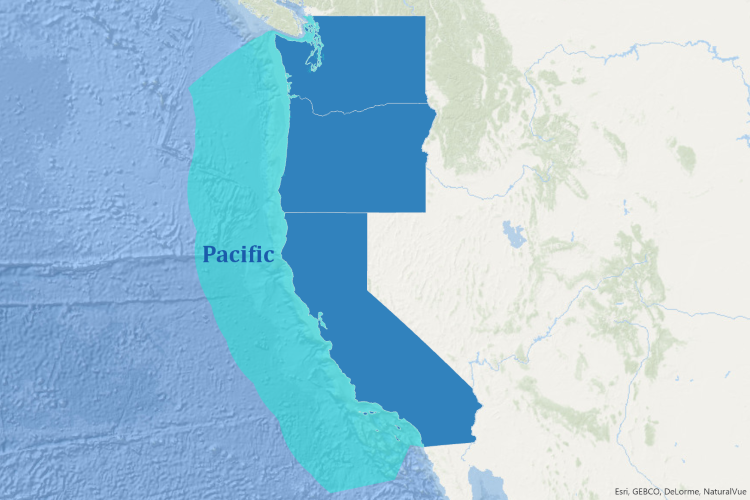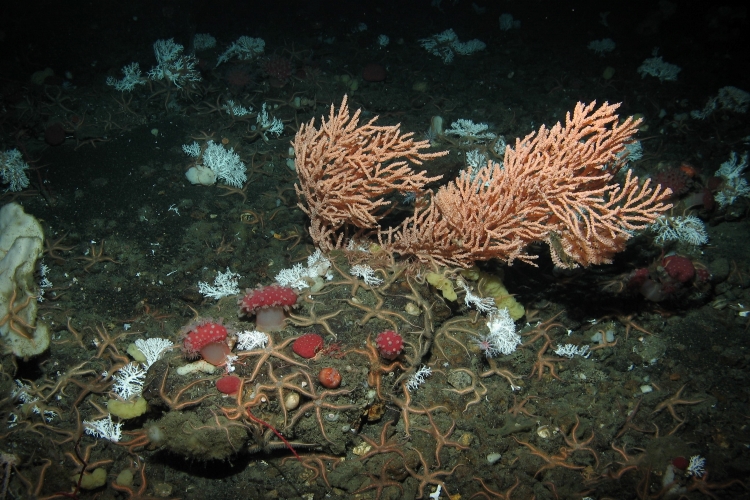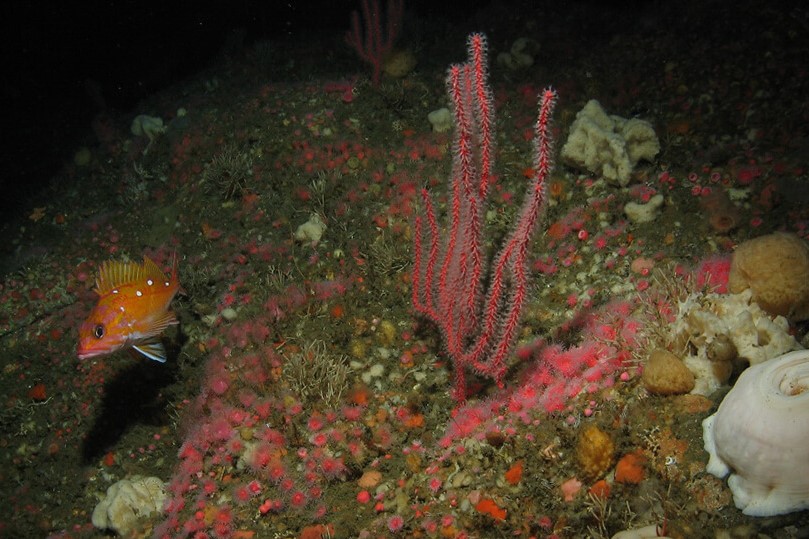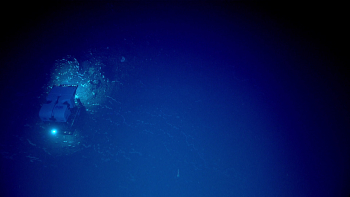The Deep Sea Coral Research and Technology Program has conducted two research initiatives in U.S. West Coast waters. The first initiative (2010–2012) focused on understanding the distribution of deep-sea coral and sponges and their importance as habitat for commercial fisheries species. The second (2018–2021) further explored fishing impacts to these ecosystems. The latest initiative involved an unprecedented level of collaboration between NOAA and partners. This led to the discovery of several new deep-sea coral and sponge species and extensive rare glass sponge mounds, and high resolution mapping of many more parts of the seafloor in the region. Between initiative years, ongoing projects in the region also support deep-sea coral and sponge conservation efforts.
The West Coast region encompasses federal waters from California to Washington’s northern border. This biologically diverse area is managed by the Pacific Fishery Management Council.

The Program’s second west coast research initiative was conducted along the coasts of California, Oregon, and Washington. It focused on informing management and protection of deep-sea coral and sponge ecosystems throughout the region. The initiative involved a close partnership with the Pacific Fishery Management Council and five California and Washington National Marine Sanctuaries—Channel Islands, Cordell Bank, Greater Farallones, Monterey Bay, and Olympic Coast, in addition to other governmental and nongovernmental collaborators. Similar to previous deep-sea coral research initiatives, activities consisted of research expeditions to survey, sample, and map deep-sea coral and sponge ecosystems. There were three main areas of focus:
- Gathering baseline data on seafloor communities before the 2020 implementation of the Pacific Council’s Amendment 28, which added and expanded seafloor trawl closures to minimize adverse effects of fishing while reopening other historically important fishing grounds
- Surveying areas with relatively high coral bycatch
- Improving our understanding of deep-sea habitats in West Coast sanctuaries
For more information on impacts to deep-sea corals and sponges on the U.S. West Coast, see Chapter 5 of the Program’s 2017 report: “The State of Deep‐Sea Coral and Sponge Ecosystems of the United States” (PDF, 45 pages). Though data from the initiative are still being analyzed, the initiative has produced many important findings that have already begun to inform fishery management decisions.

Initiative Highlights
Major accomplishments of the second initiative include the following:
- Incorporating Program data into aquaculture planning to avoid environmental impacts to deep-sea corals and sponges.
- Identifying five newly described species of coral, including one that was observed in three national marine sanctuaries.
- Developing Program-supported new environmental DNA (eDNA) technology, which has significantly advanced our understanding of deep-sea coral identification and distribution.
- Hosting a Program-supported expedition, co-funded by the National Oceanographic Partnership Program, that enabled land-based researchers to view and help guide live surveys of deep-sea coral habitat for the first time on a NOAA Fisheries West Coast expedition.
- Completing two separate 30-day, submersible visual surveys that spanned almost the entire West Coast.
In 2010, the Program launched its first research initiative off the U.S. West Coast to locate, study, and provide information for the conservation of deep-sea coral and sponge habitats. A key purpose of the initiative was to provide new scientific information for the Pacific Fishery Management Council’s periodic review of Essential Fish Habitat for groundfish species, or fish that feed on or near the seafloor. Of the more than 90 groundfish species harvested off the West Coast, many are known to inhabit areas of the seafloor where corals and sponges also occur. The initiative was designed to address some of the many questions concerning the extent and nature of these habitat associations. The results of the initiative helped to fill this important information gap for fishery managers. The second major objective of the initiative was to provide sanctuary managers with information on the location of deep-sea habitats with high conservation value within and outside of their sanctuaries. Read more about an example of this work in the Greater Farallones National Marine Sanctuary here.
Initiative field research was conducted at various sites in and around the five national marine sanctuaries on the West Coast (Channel Islands, Cordell Bank, Greater Farallones, Monterey Bay, and Olympic Coast) stretching from southern California to the northern Washington coast, as well as at seamounts in Canadian and international waters. These areas were chosen based on habitat modeling results that predicted the presence of deep-sea corals or sponges. Mapping the likely presence of these habitats provided important information for sanctuary management plans and Pacific Fishery Management Council decisions.

Initiative Highlights
Major accomplishments of the initiative include the following:
- Producing extensive new scientific information on coral and sponge habitat and its importance to other species. This included species abundance and the density of coral and sponge colonies, as well as which fish and other organisms were associated with these species in national marine sanctuaries.
- Adding of ~174,000 coral and sponge records, derived from both in situ video observations and physical fish stock assessment surveys, to the Program’s national database.
- Creating maps to illustrate areas of potential interactions between fishing gear and vulnerable coral and sponge habitats by showing hotspots of commercial fishing (using seafloor trawl, midwater trawl, and fixed gear such as pots and traps), as well as coral and sponge bycatch data.
Information provided by this initiative contributed to major habitat conservation management measures:
- In 2020, NOAA approved the Pacific Fishery Management Council’s Groundfish Amendment 28 that reopened more than 7,800 square kilometers (3,000 square miles) of historically important fishing grounds, and added more than 26,000 square kilometers (10,000 square miles) of new fishing closures to protect important habitat for groundfish. As a precautionary measure, an additional 319,000 square kilometers (123,000 square miles) of unfished deep-sea habitats were closed to seafloor-contact gear to protect deep-sea corals. For more information, see NOAA’s story map on the amendment.
- In 2015, NOAA expanded the boundaries of Cordell Bank and Gulf of the Farallones (now known as Greater Farallones) National Marine Sanctuaries to an area north and west of their old boundaries, and amended and added new regulations. Under the initiative, sanctuary scientists conducted deep-sea surveys in the expansion areas. The surveys helped to inform these decisions.
Explore below for links to regional protected area websites, workshop reports, science plans, expedition reports, and more.
- Expanding Pacific Research and Exploration of Submerged Systems (EXPRESS) Story Map (USGS)
- Global Foundation for Ocean Exploration (GFOE)
- Marine Applied Research & Exploration (MARE)
- Monterey Bay Aquarium Research Institute (MBARI)
- Ocean Exploration Trust/the Nautilus Exploration Program
- State of Deep‐Sea Coral and Sponge Ecosystems of the U.S. West Coast (NOAA Fisheries; 2017; Chapter 5)
- West Coast Groundfish Amendment 28 Story Map (NOAA Fisheries)
- West Coast Ocean Data Portal
-
List of Deep-Sea Coral Taxa in the U.S. West Coast Region: Depth and Geographic Distribution (v. 2021; PDF, 15 pages)
To make the initiatives a success, the Program leveraged its extensive network on the West Coast, which has been a hub of innovation in ocean exploration for decades. The Program’s many collaborations on the West Coast have led to the discovery of a wide array of organisms on the seafloor and have greatly expanded our understanding of deep-sea coral and sponge ecosystems.
In particular, the EXpanding Pacific Research and Exploration of Submerged Systems (EXPRESS) campaign, which is ongoing and began in 2017, has been a particularly notable partnership on the West Coast. EXPRESS relies on an extraordinary level of government cooperation, including financial resources and/or scientific expertise from eight NOAA offices, including the Northwest and Southwest Fisheries Science Centers, as well as the U.S. Geological Survey and the Bureau of Ocean Energy Management. This campaign supports researchers to leverage funding, resources, personnel, and expertise to accomplish more than a single group could have alone.
During the second initiative, EXPRESS in turn partnered with the Global Foundation for Ocean Exploration, Marine Applied Research and Exploration, Monterey Bay Aquarium Research Institute, and Ocean Exploration Trust/Nautilus Exploration Program to engage in expeditions along the U.S. West Coast and leverage capabilities and resources. For example, a 2019 EXPRESS effort involving NOAA, the Global Foundation for Ocean Exploration, the U.S. Geological Survey, and the Bureau of Ocean Energy Management focused on methane seep ecosystems was the first time that telepresence technology was used on a NOAA Fisheries West Coast expedition. Marine Applied Research and Exploration provided a remotely-operated vehicle and expert staff support for a number of initiative dives. Ocean Exploration Trust provided both its vessel the E/V Nautilus, and a support crew for key initiative expeditions.
Additionally, many of the Monterey Bay Aquarium Research Institute’s exploratory expeditions capture information on deep-sea corals and sponges. As of 2021, this organization alone has contributed 27 percent of the total records in the Program’s database. On the West Coast, and in all regions, the Program relies on partnerships like these to enhance its cost-effectiveness and expand its reach.
